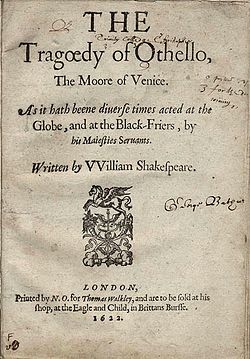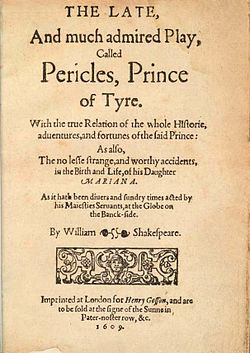
This article presents a possible chronological listing of the composition of the plays of William Shakespeare .
Contents
- Introduction
- Scholarship
- E. K. Chambers
- Modern Complete Works
- Chronology
- The Two Gentlemen of Verona (1587–1591)
- The Taming of the Shrew (1591–1592)
- Henry VI, Part 1 (1591–1592)
- Henry VI, Part 2 (1591-1592)
- Henry VI, Part 3 (1591-1592)
- Titus Andronicus (1591–1592)
- Richard III (1592–1593)
- Edward III (1592–1593)
- The Comedy of Errors (1594)
- Love's Labour's Lost (1594–1597)
- Love's Labour's Won (1595–1598)
- Richard II (1595)
- Romeo and Juliet (1595)
- A Midsummer Night's Dream (1595)
- King John (1596)
- The Merchant of Venice (1596–1597)
- Henry IV, Part 1 (1596–1597)
- The Merry Wives of Windsor (1597)
- Henry IV, Part 2 (1597–1598)
- Much Ado About Nothing (1598–1599)
- Henry V (1599)
- Julius Caesar (1599)
- As You Like It (1599–1600)
- Hamlet (1599–1601)
- Twelfth Night (1601)
- Troilus and Cressida (1600–1602)
- Sir Thomas More (1592–1595; Shakespeare's involvement, 1603–1604)
- Measure for Measure (1603–1604)
- Othello (1603–1604)
- All's Well That Ends Well (1604–1605)
- King Lear (1605–1606)
- Timon of Athens (1605–1606)
- Macbeth (1606)
- Antony and Cleopatra (1606)
- Pericles, Prince of Tyre (1607–1608)
- Coriolanus (1608)
- The Winter's Tale (1609–1611)
- Cymbeline (1610)
- The Tempest (1610–1611)
- Cardenio (1612–1613)
- Henry VIII (1612–1613)
- The Two Noble Kinsmen (1613–1614)
- See also
- References
- External links
Shakespearean scholars, beginning with Edmond Malone in 1778, have attempted to reconstruct the relative chronology of Shakespeare's oeuvre by various means, using external evidence (such as references to the plays by Shakespeare's contemporaries in both critical material and private documents, allusions in other plays, entries in the Stationers' Register, and records of performance and publication), and internal evidence (allusions within the plays to contemporary events, composition and publication dates of sources used by Shakespeare, stylistic analysis looking at the development of his style and diction over time, and the plays' context in the contemporary theatrical and literary milieu ). Most modern chronologies are based on the work of E. K. Chambers in "The Problem of Chronology" (1930), published in Volume 1 of his book William Shakespeare: A Study of Facts and Problems.


































